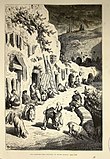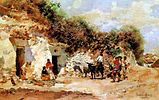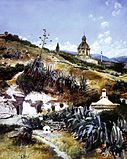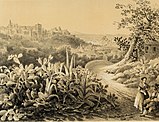Sacromonte: Difference between revisions
No edit summary |
No edit summary |
||
| Line 12: | Line 12: | ||
== Etymology == |
== Etymology == |
||
The neighborhood owes its name to the episode occurred between 1595 and 1599 on the hill of Valparaíso: the alleged discovery of [[relic]]s and the so-called ''[[Lead Books of Sacromonte|lead books]]'' or "lead books the Sacromonte" with indecipherable drawings, texts in [[Latin]] and [[Arabic alphabet|Arabic characters]] that came to be interpreted as the fifth [[gospel]]. These findings were declared a forgery in the 17th century, but led to the construction of the [[Abbey of Sacromonte]],<ref name=cec1 /><ref name=cec2 /> where today are the false relics of [[Caecilius of Elvira|Saint Caecilius]], co-patron of Granada and the lead books.<ref name=mus1 /> |
The neighborhood owes its name to the episode occurred between 1595 and 1599 on the hill of Valparaíso: the alleged discovery of [[relic]]s and the so-called ''[[Lead Books of Sacromonte|lead books]]'' or "lead books the Sacromonte" with indecipherable drawings, texts in [[Latin]] and [[Arabic alphabet|Arabic characters]] that came to be interpreted as the fifth [[gospel]]. These findings were declared a forgery in the 17th century, but led to the construction of the [[Abbey of Sacromonte]],<ref name=cec1 /><ref name=cec2 /> where today are the false relics of [[Caecilius of Elvira|Saint Caecilius]], co-patron of Granada and the lead books.<ref name=mus1 /> |
||
==Origin of the caves== |
|||
[[File:Cuevas of Sacromonte GM.JPG|thumb|left|Some of the famous ''caves'' (troglodyte houses) of Sacromonte]] |
|||
The origin of the houses excavated on the slopes of Sacromonte, which are the traditional dwelling of the neighborhood is not very clear. It is assumed that began to be built from the 16th century, when the [[Jews|Jewish]] and [[Muslims]] population was expelled from their homes, which joined to them the Gypsies of [[nomad]] customs. The caves have emerged as housing for the marginalized, located outside the Walls of the city, which meant being outside of administrative and ecclesiastical control. To dig a cave was beginning to fall apart the face of the hill where they wanted to build, making a vertical cut that served as a facade. Then opened up a midpoint arch to serve as a door and were later excavated the necessary divisions that the terrain allowed.<ref name=mus1 /> |
|||
The forms and limits of this unique house type is determined by the terrain, altitude and extent of the hills where these are, so there are not two equal caves. These elements, along with the paths, gullies, small squares, whitewashed facades and interiors form a unique landscape, with the customs and crafts of its inhabitants, give it a unique character.<ref name=mus1 /> |
|||
In addition to the troglodyte houses, another important feature of the neighborhood are the legends that relate to all corners and places, one of the most known of the Ravine of the Blacks.<ref name=mus1 /> |
|||
===19th-century drawings of Sacromonte and its caves=== |
|||
<gallery widths="159px" heights="159px" > |
|||
File:"Les grottes des gitanos, au Sacro-monte" (19929759032).jpg|''The caves of the Gipsies at Sacromonte'' by French painter [[Gustave Doré]] in his journal illustration L'Espagne |
|||
File:Marín Gares Isidoro el trato.jpg|''El trato'', by the Granadian painter [[Isidoro Marín Gares (1863 - 1926) |
|||
File:Antonio Gomar y Gomar Abadia del Sacromonte.jpg|Dome of the Abbey of Sacromonte and a caves houses by Antonio Gomar y Gomar (1849 - 1911). Today this dome is that missing in the Abbey |
|||
File:Recuerdos y bellezas de España - bajo la real proteccion de la reina y el rey; Obra destinada á dar á conocer sus monumentos y antiguedades en láminas dibujadas del natural y litografiadas por F.J. (14766313724).jpg|View of Granada from the cactuses of the Sacro Monte by Francesc Xavier Parcerisa in 1850, published in the illustration journey book Recuerdos y bellezas de España. |
|||
</gallery> |
|||
==A neighbourhood legend: The Ravine of the Blacks== |
|||
Legend has it that after the [[Granada War|Reconquest of Granada]] by the [[Catholic Monarchs]] were much the [[nobility|noble]] Arabs who made their way from [[exile]] to African lands. They carried in their hearts to the city of their parents and grandparents, it which where were born them and their children, the city that hoped to return someday. |
|||
Fearful they that on the way to the [[port]]s of [[Almuñécar]] or [[Almería]] -where they embarked-, robbed them their fortunes the [[robber]]s of roads -groups of [[soldier]]s renegade of Christians [[military]]s-, hid great treasures among the [[olive]]s that one day populated this mountain (Sacromonte).<ref name=mus1 /> |
|||
These events occurred in parallel with others, which were given freedom to many [[slavery|slaves]] owned of these noble Arab families because they found it too expensive to perform this journey with a large entourage. Many of these slaves -which were [[black]]s- knowledgeable about the comings and goings of their owners to Mount of Valparaíso (as this was called then), of the fears and thoughts of their, heard in more than one conversation between those, organized their stratagems. Recovered their freedom and without job or belongings, decided to climb the mountain and recover for theyself the treasures that had once been of their owners.<ref name=mus1 /> |
|||
They dug and dug into the slopes of the ravine without known success, and exhausted by the effort and no alternative shelter, did in these holes, which subsequently conditioned resulting in the caves that became their homes. Hence comes the name of "Ravine of the Blacks", being their first inhabitants of this race. |
|||
Later, already mixed with the inhabitants of [[Gypsy]] ethnic, they conducted more than a [[spell]] in search of the exact place where the treasures were hidden. It is known the mysterious doings of some old witch "ferminibí" talking sometimes with the [[water]] and others with [[fire]], or staring unblinking the [[basin]] of water, trying to get some clues with which to find the lost treasures, of which at present it is unknown whether were discovered by any of those seekers, who secretly appropriated them, or if they keep hidden anywhere near here.<ref name=mus1 /> |
|||
== Places of tourist interest == |
|||
[[File:Abadía del Sacromonte III.JPG|thumb|Complex of the Abbey of Sacromonte]] |
|||
[[File:San Gil y Sta Ana Granada.jpg|thumb|Iglesia de Santa Ana y San Gil (16th century)]] |
|||
=== Abbey and College of the Sacromonte; ''Holy Caves'' === |
|||
In addition to the numerous caves, the main monument of the neighborhood is the [[Abbey of Sacromonte]], built by Archbishop Pedro de Castro y Quiñones in 17th century at the top of the hill, where appeared the alleged relics and other remains that would have been of the first Christians of Granada and [[Evangelization|evangelizers]] of the Roman [[Hispania Baetica|Baetica]], including Saint Caecilius, [[martyr]] and first bishop of the city, in the 1st century AC, and other apostolic figures, companions of [[James, son of Zebedee|Saint James]]. Annex to the abbey also found the College of Sacromonte, founded also by Pedro de Castro.<ref name=gg1 /> |
|||
==Fiestas== |
==Fiestas== |
||
Revision as of 18:22, 7 June 2016



Sacromonte, sometimes also called Sacramonte is a traditional neighbourhood of the eastern area of the city of Granada in Andalusia, Spain. It is one of the six neighbourhoods that make up the urban district Albayzín and limits with the neighbourhoods of Albayzín, San Pedro, Template:Ilc, El Fargue and Haza Grande. In 2009 had 578 inhabitants.[1]
It is located on the hill and valley of Valparaíso, in front of the Alhambra, emblematic places of Granada, occupying both banks of the Darro River, whose name seems to derive the phrase "D'auro" ("of gold") for its famous gold-bearing sediments.
It is the traditional neighborhood of the Granadian Gipsies, who settled in Granada after the Christian conquest of the city in 1492. It is one of the most picturesque neighborhoods of the city, by the landscape and its cave houses, installed in whitewashed caves that serve as housing, where it hear torn touches of guitars cantes and quejíos (Andalusian traditional sings), that accompany the zambras (gypsy traditional dances of flamenco), which became one of the tourist reclamations most renowned of Granada.[2]
The gypsies of Sacromonte have a dialect itself, the "Calé", which is currently very little used, derived, according to tradition, from the India, where also have been the gypsies who arrived in Spain in 15th century after wade through Europe and Africa. The Gypsies of Sacromonte were portrayed by the poet Federico García Lorca in his book of poems Romancero Gitano.[3]
Etymology
The neighborhood owes its name to the episode occurred between 1595 and 1599 on the hill of Valparaíso: the alleged discovery of relics and the so-called lead books or "lead books the Sacromonte" with indecipherable drawings, texts in Latin and Arabic characters that came to be interpreted as the fifth gospel. These findings were declared a forgery in the 17th century, but led to the construction of the Abbey of Sacromonte,[4][5] where today are the false relics of Saint Caecilius, co-patron of Granada and the lead books.[3]
Origin of the caves

The origin of the houses excavated on the slopes of Sacromonte, which are the traditional dwelling of the neighborhood is not very clear. It is assumed that began to be built from the 16th century, when the Jewish and Muslims population was expelled from their homes, which joined to them the Gypsies of nomad customs. The caves have emerged as housing for the marginalized, located outside the Walls of the city, which meant being outside of administrative and ecclesiastical control. To dig a cave was beginning to fall apart the face of the hill where they wanted to build, making a vertical cut that served as a facade. Then opened up a midpoint arch to serve as a door and were later excavated the necessary divisions that the terrain allowed.[3]
The forms and limits of this unique house type is determined by the terrain, altitude and extent of the hills where these are, so there are not two equal caves. These elements, along with the paths, gullies, small squares, whitewashed facades and interiors form a unique landscape, with the customs and crafts of its inhabitants, give it a unique character.[3]
In addition to the troglodyte houses, another important feature of the neighborhood are the legends that relate to all corners and places, one of the most known of the Ravine of the Blacks.[3]
19th-century drawings of Sacromonte and its caves
-
The caves of the Gipsies at Sacromonte by French painter Gustave Doré in his journal illustration L'Espagne
-
El trato, by the Granadian painter [[Isidoro Marín Gares (1863 - 1926)
-
Dome of the Abbey of Sacromonte and a caves houses by Antonio Gomar y Gomar (1849 - 1911). Today this dome is that missing in the Abbey
-
View of Granada from the cactuses of the Sacro Monte by Francesc Xavier Parcerisa in 1850, published in the illustration journey book Recuerdos y bellezas de España.
A neighbourhood legend: The Ravine of the Blacks
Legend has it that after the Reconquest of Granada by the Catholic Monarchs were much the noble Arabs who made their way from exile to African lands. They carried in their hearts to the city of their parents and grandparents, it which where were born them and their children, the city that hoped to return someday.
Fearful they that on the way to the ports of Almuñécar or Almería -where they embarked-, robbed them their fortunes the robbers of roads -groups of soldiers renegade of Christians militarys-, hid great treasures among the olives that one day populated this mountain (Sacromonte).[3]
These events occurred in parallel with others, which were given freedom to many slaves owned of these noble Arab families because they found it too expensive to perform this journey with a large entourage. Many of these slaves -which were blacks- knowledgeable about the comings and goings of their owners to Mount of Valparaíso (as this was called then), of the fears and thoughts of their, heard in more than one conversation between those, organized their stratagems. Recovered their freedom and without job or belongings, decided to climb the mountain and recover for theyself the treasures that had once been of their owners.[3]
They dug and dug into the slopes of the ravine without known success, and exhausted by the effort and no alternative shelter, did in these holes, which subsequently conditioned resulting in the caves that became their homes. Hence comes the name of "Ravine of the Blacks", being their first inhabitants of this race.
Later, already mixed with the inhabitants of Gypsy ethnic, they conducted more than a spell in search of the exact place where the treasures were hidden. It is known the mysterious doings of some old witch "ferminibí" talking sometimes with the water and others with fire, or staring unblinking the basin of water, trying to get some clues with which to find the lost treasures, of which at present it is unknown whether were discovered by any of those seekers, who secretly appropriated them, or if they keep hidden anywhere near here.[3]
Places of tourist interest


Abbey and College of the Sacromonte; Holy Caves
In addition to the numerous caves, the main monument of the neighborhood is the Abbey of Sacromonte, built by Archbishop Pedro de Castro y Quiñones in 17th century at the top of the hill, where appeared the alleged relics and other remains that would have been of the first Christians of Granada and evangelizers of the Roman Baetica, including Saint Caecilius, martyr and first bishop of the city, in the 1st century AC, and other apostolic figures, companions of Saint James. Annex to the abbey also found the College of Sacromonte, founded also by Pedro de Castro.[2]
Fiestas
- Pilgrimage of Saint Caecilius, on the first Sunday of January.[6]
References
- ^ Cite error: The named reference
popwas invoked but never defined (see the help page). - ^ a b Cite error: The named reference
gg1was invoked but never defined (see the help page). - ^ a b c d e f g h Cite error: The named reference
mus1was invoked but never defined (see the help page). - ^ Cite error: The named reference
cec1was invoked but never defined (see the help page). - ^ Cite error: The named reference
cec2was invoked but never defined (see the help page). - ^ Cite error: The named reference
id20080128was invoked but never defined (see the help page).
External links
- http://oldportal.euscreen.eu/play.jsp?id=EUS_4C74D7CB6A004DED83B7757E395480C5 (Flamenco recording from 1962 in Sacramento)
- https://www.youtube.com/watch?v=0sYNnvyroGU (The Wise Men of Sacromonte, Documentary 2013)
- http://granadamap.com/abadia/indexsp.htm (in Spanish)
- http://servicios.ideal.es/guia/abadia.html (in Spanish)
- http://granadainfo.com/canastera/cdesacroen.htm (on the gitano caves)



